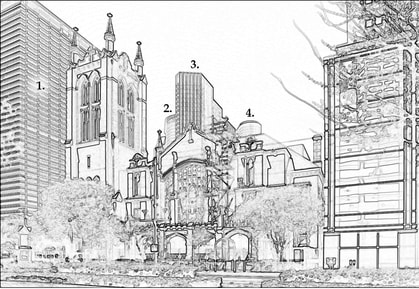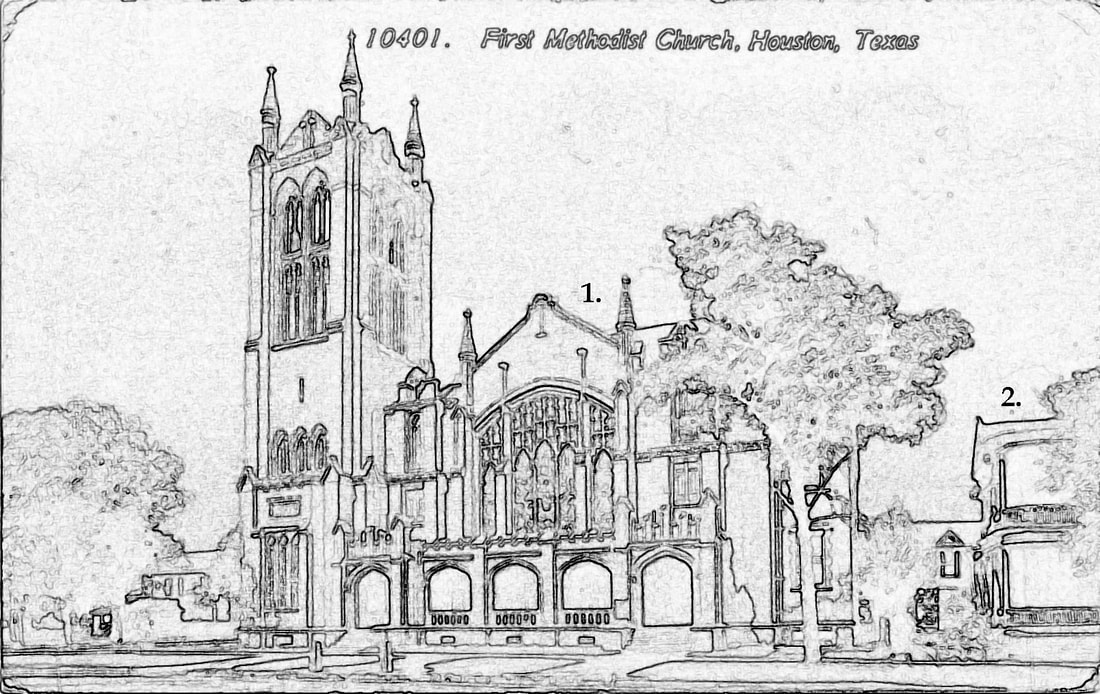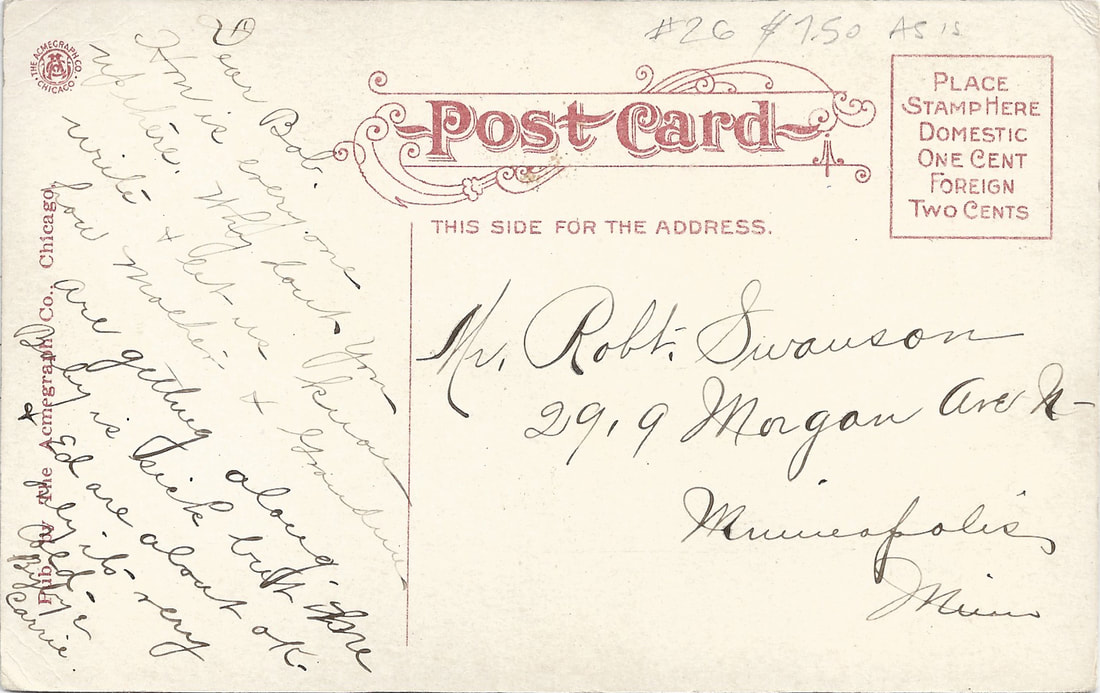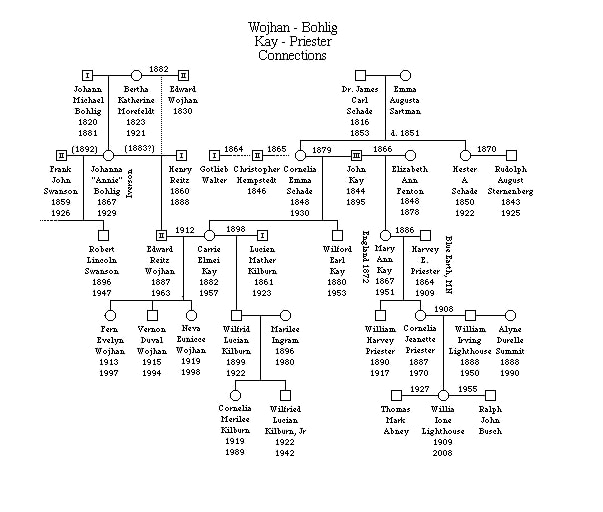Methodist Church
Front Entrance
|
January 1914: 1. The Methodist Church was only two years built when this postcard was sent, the congregation having moved from the Shearn Methodist location in 1912 when the lot at [address] was sold. The church leadership thought the site was too busy with commerce, and they wanted to attend services in a quieter neighborhood on the edge of town. In those days the corner of Bell and Main was a neighborhood of large homes and spacious gardens. The red house on the right (2.) with generous porches was a boarding house operated by Miss Elizabeth Kirby during most of the time this postcard would have been available for purchase. She was born in Massachusetts of Irish parents, but further information is not available.
Out of the frame to the right beside Kirby’s Boarding House was the home of the Taub Family, tobacco merchants at this time, including Ben Taub (1889-1982), who would become an important Houston bachelor philanthropist, namesake of the city's charity hospital, Ben Taub Hospital. |

2 April 2019: The multistory structure dominating the right is Travis Tower, a 21 story office building filling the north half of the block. When it was built in 1955 by Conoco, a petrochemical company, it was topped with a rotating triangle which changed color to reflect weather conditions. The Methodist Church, once towering over Houston’s primary residential district, has become dwarfed by behemoths of Houston’s diverse economy: [left to right] 1) The former ExxonMobil Building at 800 Bell Street (The Humble Building, Exxon Building) with 44 floors (1963); 2) Five Allen Center at 1500 Louisiana Street (Enron Tower II South) 40 stories (2002); 3) United Bank Plaza at 1415 Louisiana (WEDGE International Tower) 43 stories 1983; 4) Four Allen Center at 1400 Smith Street (Enron Building) 50 stories (1983).
|
|
Postmarked: Not posted
To: Mr. Robt. Swanson 2919 Morgan Ave N Minneapolis Message: Dear Bob. How is everyone up there. Why dont you write and let me know how mother & grandma are getting along. Baby is sick but I me & Ed are about ok. only it is very cold Goodbye Carrie Carrie wrote this postcard from Houston to her husband Ed Wojhan’s half-brother, Robert Lincoln Swanson back in Minneapolis where Ed’s blended family was from. The story of Carrie and her husband’s mother and grandmother is an orphan’s tale of child marriages and early deaths. Their parallel narratives no doubt drew them together.
The card was not posted so probably included in a letter, so the date is not completely certain. She mentions a sick baby and no other children, and indicates that the weather is very cold. Her first child, Fern Evelyn was born 18 May 1913, so the postcard must have been written in late 1913 or more probably in early 1914 since statistically the coldest month in Houston occurs in January. Robert Lincoln Swanson was the son of Frank J. Swanson, an immigrant from Sweden who came to America in 1875 and Johanah Bohlig. Johanna “Annie” Iverson Bohlig (born 26 November 1868) was the daughter of Bertha Katherine Morefelt and Johann Michael Bohling. Annie’s first relationship had begun before the age of 15 with a man nearly 9 years older, Henry Reitz, son of Fred Reitz of Chaska, Carver County, MN. Henry took a job with Lake Minnetonka Navigation Company on a passenger steamer between Duluth and Buffalo. Just before his 28th birthday he fell sick with a “brain fever” and died in Buffalo, NY (22 November 1888). His son Edward was only two years old, and Annie, not yet 20 years old, was ill prepared for motherhood. Stepping into the void, Annie’s mother, anxious to provide an intact home for the boy, spirited him away and raised him as her own. The grandmother gave the child the surname of her second husband, Edward Wojhan, but in adulthood the child went by Edward Reitz Wojhan. Annie would marry again when she was 24 to Frank Swanson, a Swedish railroad worker who had immigrated in 1880. By 1910 they lived in Minneapolis, and Edward, recovered by then from his grandmother, lived with them as eldest son. Included in the family were Ralph (born 1893), George (1898), Robert, the recipient of the postcard (1896), Arthur (1900), Esther (1903), Elmer (1907). Edward Wojhan, perhaps feeling more rootless than the other Swanson family members, felt free to travel to Texas to find himself, which he did in 1912. That same year on 14 September 1912 he married Carrie Elmei Kay, the author of the postcard here under study. Carrie asks, “how mother and grandma are getting along,” but in view of Edward’s complicated history sketched out above, Carrie’s query may have been a bit of a loaded question. The mother is, of course, Annie, and the grandmother Bertha Katherine. Grandma at this time was 91 years old, widow of two husbands, Johann Michael Bohlig (1820-1881) and Edward Wojhan (1830 - 1882), and late in life, a Mr. Reudger (her surname on the census of 1920). Carrie herself was a life-long Houstonian, born in Houston 24 March 1882, the daughter of John Kay (1844 – 1895), an immigrant from Pigslea, Lancashire, England who immigrated to America at 40 on board the steamship Gallia. Carrie’s mother was Cornelia Emma Schade (3 September 1848 – 1930), daughter of Dr. Carl Schade (1816 – 1853), an immigrant from Leipzig, Germany, and Emma Sartman (1820 – 1851). She and her younger sister, Hester A., were orphaned before Cornelia was 3 years old by the death of her mother (9 June 1851), and when she was 5 by the death of her father (25 December 1853). The fate of Hester is uncertain, but Cornelia was taken under the custody of Peter W. Gray, Judge of the Harris County District Court, and his wife Abbie Jane Avery, a childless couple. C. Schade is found as a ten year old in the household on the census of 1860, but it is unclear whether she was a domestic servant or adopted child. Peter Gray was an important person in the history of Houston, linked to many early events in the history of the Republic and later the State of Texas, the City of Houston. Judge Gray had served in the Republic of Texas and the Confederate States in various capacities, including Republic legislature, state legislature and senate, Confederate State congress, military aide to General McGruder in the Battle of Galveston, District Attorney and Justice of the Texas Supreme Court in 1874 when he died. Gray was a founding member of Christ Church and long-time vestryman (1842-1874), master of the Holland Lodge Masons, and namesake for Gray County in Texas and Gray Street in Houston. (See Christ Church for more details of his contribution to the history of Texas). |
Twelve days after her 16th birthday (on September 15, 1864), while doubtless still under the care of the Gray’s, Cornelia married Gotlieb Walter in Harris County. It is uncertain how this relationship ended, but within seven months while still not yet 17 she was married for a second time to Christoff Hempstedt on March 10, 1865. Christoff was born in 1846 to Henry and Mary Hempstedt, immigrants from Hannover, a tailor and saloon keeper at the corner of Washington and 9th in 1860.
This part of Houston northwest of downtown across Buffalo Bayou was then called “Vinegar Hill” because of vinegar manufacture in the neighborhood and it was among the poorer parts of town, an early red-light and entertainment district catering to gambling, prostitution, violence, and the sale of drugs. According to the Handbook of Texas, “Vinegar’s Hill’s main business was a saloon located at the corner of Washington Avenue and 9th Street.” That would have been the Hempstedt Saloon. That part of Houston has largely vanished under the overpasses of I-45 and I-10, but 9th Street would have underlain the northernmost extension of Bagby Street beside now-abandoned Tennyson Hotel on Franklin Street. What happened to Christoff Hempstedt is not clear, but in 1879 Cornelia married John Kay, who had a daughter, Mary Ann Kay, from his first marriage in Lancastershire, England to Elizabeth Ann Fenton. Cornelia’s step-daughter married Harvey Priester and they named their daughter Cornelia Jeanette “Nettie” Priester after Cornelia. Nettie is the author of another postcard in this series, Sam Houston Park [See this narrative for information about the sixth ward neighborhood and the various Priester connections]. Carrie’s father, John Kay, like her mother, was also orphaned at an early age by the death of his mother when he was 14 followed by the death of his father when he was 18. Like his father, John Kay died young, when Carrie was 13, leaving her mother Cornelia to care for Carrie and her 15 year old brother, Wilford Earl Kay. Carrie was married at 16 with her mother's permission to Lucian Mather Kilburn, and they had one son, Wilfred Lucian Kilburn, Jr. born 6 August 1899. They divorced before 1910, but continued for a time to live together off Heights Boulevard, at #123 West 17th with Carrrie’s widowed mother, Cornelia Kay. Lucien was an electrician with his own company at 816 Travis and Carrie worked as a bookbinder for Cargill Company [Cargill was employer to another person in this series, Jack Doebele (see Savoy)] and later J. V. Dealy Company at 211 Fannin. Bookbinding was an important trade in the early 20th century when custom-made ledger books for accounting records was printed locally rather than purchased through national companies. By 1920 Carrie and Ed were living at 348 West 29th street in Houston Heights with Cornelia and three young children: Fern Evelyn (1913), Vernon Duval (1915), and Neva Eunice (1919). Carrie seems to have led a rather independent life, and early in their marriage she is sometimes listed with Edward and sometimes at different addresses. They lived on Hempstead Road in Houston Heights in 1920 before moving to #348 West 29th (now covered over by Loop 610) where Edward worked as a foreman in construction 1930-1940. Carrie’s son by her first marriage was on his own by 1920, married to Marilee Ingram with a daughter Cornelia Merilee (b. 1919). They would have another child, Wilfred Lucian, Jr. in March 29, 1922. Sadly, Wilfred Lucian Kilburn, Sr. would perish in a fire at a Texas Company facility on December 30, 1922 at age 23 when his son was 9 months old. In a double jab of fate, that son, Wilfred Lucian Kilburn, Jr. would die before his 21st birthday in South Texas from a combination of influenza and heart disease on 29 November 1942 in Pharr, Texas, while under the care of his mother and step-father, Ralph Grasso. Catherine Bohlig (Bertha Morefelt) died in Minneapolis in January 1921 at the age of 98. She is memorialized in German on the tombstone of her first husband, Johann Michael Bohlig (1820-1881) in Valley Cemetery in Shakopee, Scott County, MN. Catherine had by this time been living in Minneapolis for some time, and it is not clear whether she is interred in Valley Cemetery. Annie Swanson died in 1929 and is buried in Crystal Lake Cemetery in Minneapolis. Cornelia Kay died 22 November 1930 of heart problems and is buried in an unmarked grave in Glenwood Cemetery in the Priester Family plot. The informant on her death certificate was Carrie Wojhan. Carrie died at Heights Hospital on 28 October 1957 of a coronary thrombosis; Edward Wojhan died 15 June 1963. They are buried in Woodlawn Cemetery. |



